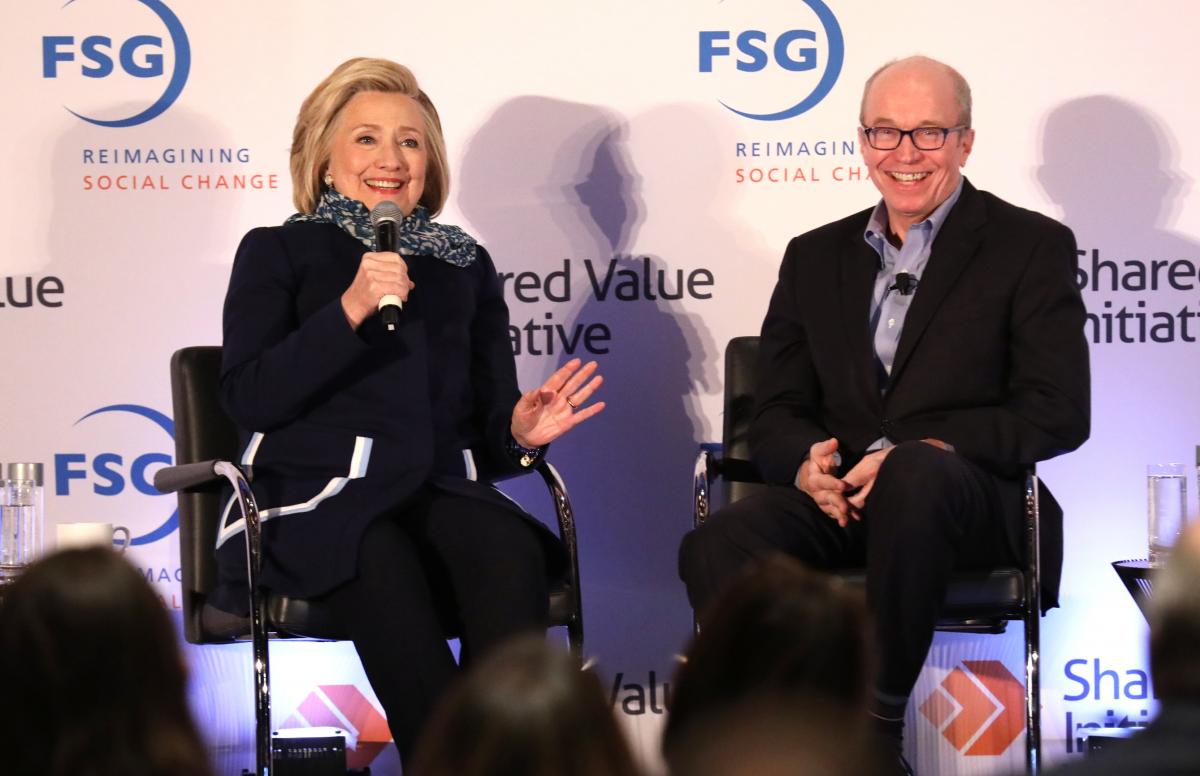Laura Herman discusses shared value and gender equity with Steven Puig and Elizabeth Vazquez.
In the age of #metoo and #timesup, companies are eager to strategically consider how best to strive for gender equity within their organizations. Moving beyond technical fixes in the HR policies and practices, companies are increasingly seeing opportunities for improved competitiveness as they consider the role of women inside and outside their organization’s walls.
We had several illuminating conversations about the intersection of gender equity and shared value last week at the Shared Value Leadership Summit. The Summit brings together approximately 400 global leaders every year in New York to explore opportunities for shared value across industries and geographies.
To kick off the Summit, we hosted a dozen business leaders in partnership with Win-Win Strategies for a dynamic dinner discussion about how their companies are setting the stage for long-term investments in gender equity. This includes building the business case for investing in women, and aligning strategies across the value chain, internal operations, CSR and philanthropy that support core business objectives.
The participants came from diverse industries including retail, food and beverage, financial services and more. Many expressed that while macro studies like the Power of Parity and others over the last decade are powerful, they don’t reflect individual company strategies, and hence, don’t go far enough in helping executives who are trying to make the economic argument for gender equity and design strategies that drive impact at multiple levels. Similarly, the many studies that explore intersectionality and link all kinds of diversity with improvements in typical business yardsticks (like return-on-sales and earnings-per-share) haven’t been fully convincing when it comes to building consensus around how to prioritize and pursue gender equity with the same zeal as other business imperatives. Overall, there was a real appetite amongst participants for greater specificity in terms of defining the business benefit and strategies in order to effectively make the case for investing more intentionally in gender equity.
On the second day of the Summit, I spoke with Stephen Puig, the CEO of Banco BHD Leon in the Dominican Republic and Elizabeth Vasquez, CEO of WeConnect, about specific opportunities in serving women consumers and in connecting women to corporate supply chains.
Stephen shared the bank’s success in enrolling women in credit and savings products and how their campaigns to target women also sought to raise awareness around intimate partner violence—an issue that affects a third of women globally. This campaign resonated strongly with the millennial consumers in the Dominican Republic, a tough-to-reach segment for retail banks. In addition to creating social impact and building a relationship with the millennial market, the campaign has had a 100 percent rate of return since the launch, leading to a 13 percent increase of female customers per year over the last 4 years and boosting the number of products sold to women customers from $600,000 to $1.1 million per year.
On the supply side, gender has been insufficiently taken into consideration along the supply chain despite emerging evidence on the lost business potential in these areas. This includes both hiring women into supply chain roles within firms and procuring from women-owned businesses and suppliers in company supply chains. Elizabeth shared how companies who are indeed sourcing from women-owned business are enjoying improvements in the reliability and quality of procurement. These are not “cute” arrangements with women’s cooperatives. Elizabeth cited multiple examples of women business owners she’s worked with recently during our conversation, including one in Bangladesh who employs 20,000 people in the textile industry and another whose company makes 62 million garments a year for their partnership with Walmart. These are multimillion-dollar deals with women-owned firms that can employ tens of thousands of employees—many of whom are also women.
These 2 stark examples of how gender equity yields measurable business benefits were powerful testimony to the opportunities companies have to create shared value by applying a gender lens to their work.

The closing speaker of the Summit was former Secretary of State, and the first female presidential candidate in the U.S., Hillary Rodham Clinton. Secretary Clinton had many insights for the audience, but among her most emphatic points were those related to women in business and what she has seen in the global market.
She reiterated the important points around inclusive supply chains and brought additional texture to the points around how companies can succeed by driving relentlessly towards increasing the number of women in business leadership, remarking that:
Her emphatic statement that if we want to grow the global economy, we need to open the door for women, left us all excited for the potential for more companies to see gender equity as a critical lever for driving their own shared value strategies.
If you are interested in learning more about our gender work, please get in touch:
